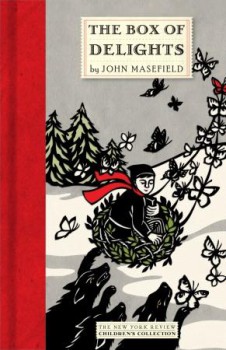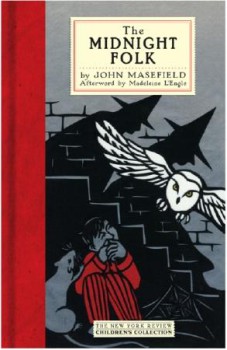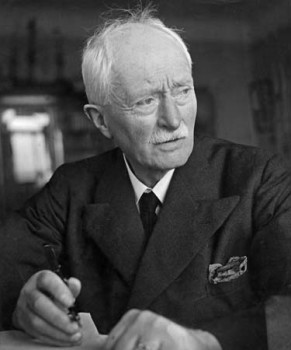A Review of John Masefield’s Christmas Book The Box of Delights

Lately I’ve become interested in what may be termed “seasonal” books — stories or novels that are perennially suited for a particular time of year. I long have considered Hope Mirrlees’s Lud-in-the-Mist a spring book. Natalie Babbit’s Tuck Everlasting is a summer book. The fall season has any number of offerings: Ray Bradbury’s Something Wicked This Way Comes, the anthology October Dreams, Washington Irving’s “The Legend of Sleepy Hollow,” and this last fall I discovered John Masefield’s The Midnight Folk.
Perhaps in due time I will look at this last in more detail, but for now I want to examine Masefield’s “Christmas Book,” The Box of Delights, something that sits well alongside Charles Dickens’s A Christmas Carol, Dr. Seuss’s How the Grinch Stole Christmas, and Clement Clarke Moore’s “A Visit from St. Nicholas.”
The Box of Delights was published in 1935 and, like The Midnight Folk, contains many delightful period terms. I choose as just one example the word “scrobble,” which means to kidnap. In this book, all sorts of people get scrobbled. The antagonist of this book, Abner Brown, who also is the antagonist of The Midnight Folk, is attempting to steal the Box of Delights from “Punch and Judy man” Cole Hawlings, who has entrusted the Box to Kay Harker, the protagonist both of this book and of The Midnight Folk. Brown scrobbles Hawlings and, unable to get any information out of that magician, scrobbles anyone who was in the vicinity of Hawlings: two of Kay’s friends and all of the clergymen and servants attached to the Tatchester Cathedral. By the end of the book, the crisis of the tale becomes in equal measure one of keeping the Box from Brown’s villainous clutches and one of returning all of the religious to the Cathedral in time to hold the Christmas services at midnight.
What is the Box, exactly? Well, it appears to be some kind of time machine. By looking into it, Kay not only goes into alternate faerie dimensions, wherein he encounters Herne the Hunter, “a great man, antlered at the brow, dressed in deerskin and moving with the silent, slow grace of a stag,” but also the Trojan War, because, as Herne tells Kay when he is attempting to seek out Arnold of Todi, the inventor of the Box, “There’s one part [of Time] that everybody goes to and that’s the Trojan War.” This statement is just one of many delightfully fey observations delivered by Masefield with such aplomb that the reader readily believes them, this one not just for its mythological significance but also its poetical significance, when one considers how it has long been an established tradition for national chroniclers to connect the origin of their matter to the battle for Helen. Time is fluid, though, for Kay only briefly acquaints himself with the Trojan war before getting nearer to what Arnold of Todi later terms “Anno Domini” when some men in a pirate ship draw near to Kay and ask, “Are you sick of the Mediterranean? We are.”
The reader by now should be getting some indication of Masefield’s clever, understated humor, and this is only one reason to reread the book during many a Christmas season. In order to get to some other reasons, I should mention two other things the Box may do: by turning a knob in one direction, Kay may “go fast.” By turning the knob another, he may “go small.” By turning the knob in both ways in succession, he may do both. And in this way he is able to in effect teleport all over the countryside and observe many an important situation in relative invisibility, because he is as small as a bit of rag and mistaken for one at one point. Two other reasons to read or reread this book are Masefield’s treatment of Faerie and the natural world, both of which, in some ways, are the same thing.

For my understanding of the natural world here I’m going to follow Shakespeare’s observation that anything produced by Man is natural, since man is himself a product of nature. One of the chief joys of reading old books is also the joy of reading fantasy – to immerse oneself in a strange and yet remotely familiar world. Masefield’s 1935 Tatchester is as wondrous as many a secondary world. This is demonstrated by the following passage, one I happened to read aloud when someone in my household desired to hear what I was reading at the moment:
Kay went on to Lower Lock, which was a sort of double alley of very old houses near Tibbs’s Wharf where the barges were lying up for Christmas. The two alleys were known as Lockside and Quayside. There was a brew-house at Lockside, and in between the two alleys was a little public-house known as the Lock and Key. A lot went on down at Tibbs’s Wharf, around the Lock and Key. The bargemen used to come there, “just like pirates from foreign parts,” so Ellen said, and would fight the landsmen for half-a-crown or a gallon of ale (or for the fun of it if times were hard). Then the poachers used to bring their game there, and plan their big drives with the men from the city shops. Then there was cock-fighting, and sometimes dog-fighting; and men would come in sometimes from the cities, to nobble horse at the races, or to burgle a house, and so away. No matter at what time of the day or night you came near to Lower Lock you would always meet a dirty boy doing nothing in particular hanging about on the approaches. If the boy whistled “God Save the King,” it was a sign that you were all right, but if he whistled “Holy, holy, holy,” all those who felt uneasy used to get under cover.
Masefield’s depiction of Faerie is just as convincing. In one episode, Kay and all his friends “go small” and prevent themselves from being scrobbled by drifting down a river in their own toy boats. They secure their boats on the roots of an elm tree, a field mouse invites them into the tree, and the children realize that the tree is hollow. What’s more, they learn that this hollow tree has been left by the Good People. Tolkien, judging by comments he has made in “On Fairy Stories,” would approve of the way the field mouse speaks of this departed race.
“D’you mean Fairies?” Susan [one of Kay’s friends] asked.
“No, very, Very Good People,” the field mouse said: “very clever, very beautiful and very wise. But they went away. It’s a long time ago,” the field mouse added. “I don’t know the rights of it. It isn’t wise to talk about those People, but, of course, everybody knows they were very, very good.”
Hopefully you are still detecting Masefield’s clever wit. And now he will enchant you, for, in one of the rooms of the Good People’s abandoned hollow tree, the children encounter an ivory horn, and “underneath the horn, written in letters of flame which flicker to and fro, are the words:
He that dares blow must blow me thrice.
Or feed th’ outrageous cockatrice.”
Kay of course gives it a blow. I should mention here that in this room “the walls are hung with banners and with portraits of extraordinary brilliant people, whose eyes seem to move in their painted heads.” When Kay blows the horn once, “a strange noise as sweet as the winter singing of the storm-cock comes from the ivory. With a little tinkle and clack all the frames fall from the portraits on the walls.” The second blow is “like the first calling of the cuckoo when he comes in April. The children hear a sort of gasp of breath from the portraits on the walls and all the figures of the portraits turn their heads and look at Kay.”
I won’t tell you what happens with the third blast. Or maybe Kay doesn’t blow it and feeds the outrageous cockatrice!

My last observation shall be in relation to the nature of evil in this book. In this book, Kay’s first encounter with evil (though we may be tempted here simply to call it “badness” or “misguidedness”) entails Kay’s interaction with two criminals who are disguised as students from a nearby Missionaries College. One is a “foxy-faced.” They deftly and convincingly use a card game to cheat Kay out of some money. This, in true Christmas fashion, tugs at the heartstrings of the reader, who sees an amiable, good-hearted boy getting taken advantage of by fellow train passengers. We rally when we see Kay’s powers of observation. He at first likes one of the men, “who had a round, rosy, chubby face, with fair hair; and yet there was something about him… Kay couldn’t quite put it into words… he had a kind of a… sort of a… It was more in his eyes than in anything else.” And, after losing in a game that these two brilliantly got Kay to play, even though Kay didn’t want to and even though this practice clearly went against previously established principles, Kay determines that he “won’t play cards anymore … Nothing shall induce [him].” Despite this, we are certain that these smooth operators in fact will persuade him to do so, though events transpire to disrupt whatever further plans they had.
But these figures only serve an agent of even greater Evil. Abner Brown, a witch who was merely after treasure in the previous book, in this one appears to want the Box of Delights in order to increase his already impressive repertoire of magical abilities. At his disposal are masked servants, motor-cars that can transform into airplanes that can take off from almost anywhere and hover near-silently in the air like dragonflies, a Boy who appears when summoned and who gets punished when insolent by having his head and his legs boxed into his chest like a collapsing telescope and then gets transported into a waterfall to blubber and shiver (this seems like a sketchy summation, but I’m giving you about as much information here as Masefield does!), a bronze head that tells Brown what he wants to know (though in riddles), and red, winged figures. By the end of the book, the reader gets a unique window into how Brown rationalizes his behavior, and it struck me as quite sophisticated for a “children’s book.” I should say that, at this juncture, Brown has stolen a number of jewels from a number of very wealthy people, and he is about to murder a whole lot of clergy:
And think of all the benefits that I have conferred; the stimulus that I have given to the jewel trade. Half the noble families of England, you might say of Europe, have had to buy new jewels because of me. Think of the impetus that this has given to the mining industry. Many black and brown creatures in remote parts of the world are munching the banana of content in full employment when, but for little Abner, they might be sitting in the sun doing nothing – starving. Now, very likely, they can even go to the cinema. Then, too, the benefit that I conferred upon the Church. All the clergy of the diocese who have perhaps had embittered years thinking that they would never get promotion – what is the clerical name, by the way: not promotion, not translation – preferment. Now, at one swoop, the curate becomes a rector, the rector a canon, the canon an archdeacon, the archdeacon a dean and the dean a bishop. Think, too, what I do to the tourist industry. Thousands will come to Tatchester to see the scene of the recent outrages: hotels will prosper: tearooms will enlarge their premises. The master masons of Tatchester will obtain an enormous sum of money by public subscription in order that they may put up a memorial to the martyred clergy …
Thus might evil and criminal activity – sanctioned and otherwise – be justified. There also appears to be a touch of criticism concerning colonialism here. In conclusion, this is a wise and heart-warm book, one that I would do well to return to on many winter nights.
I think “scrobble” is an invention of Masefield’s and is not really a period word, so credit to Masefield for enriching the language. This was one of my favourite books when I was a child – read time after time. Then I “lent” my copy to a friend and never saw it again. This is definitely a book I want to reread as I approach my dotage. I find it particularly intriguing that this is one of Alan Garner’s favourite works and that he read it constantly, as a child. He cites it in a couple of interviews as being a particular influence. Your article brought back some happy memories. Thanks. Neil
I’ve always regarded ‘The Box of Delights’ as a big influence on ‘The Dark is Rising’; ‘The Box of Delights’ is much lighter in tone but the essential flavor and structure – a boy, the english countryside at Christmastime, dark forces at work – is very similar. My copy of Cooper’s book even had Herne the Hunter on the cover!
Re ‘scrobbling’ – sounds like a deliberate hybrid of ‘scrumping’ (an english term meaning to steal apples, and ‘nobble’ another english word meaning to ‘obtain dishonestly’. Then again, maybe not.
Thanks, both, for the clarifications on “scrobble.” I’ve searched the Shorter OED that I have in my household, and Etymology Online, both to no avail. When I get a chance, I may look into the complete OED at some university library. I don’t suppose either of you have had that chance?
“The Dark is Rising”, actually, is another book I reread for the season (having read it only once in my childhood and only remembering striking, suggestive images — Herne the Hunter — or at least the antlers — featured prominently in my memories). I even considered wrapping it into this post as a kind of dual/comparative review, but I found I had much less to say about that book than “The Box of Delights”.
This is certainly one I’ll have to add to my to-read list (as well as his intriguing autumn companion work, The Midnight Folk — which grabs me by the title alone).
Btw, welcome to the ramparts of The Black Gate with your debut blog post, Gabe!
Gabe,
Very late reply to your post from almost three weeks ago, but I just checked the online version of the OED, (I work at a college library that has online access) and there is no entry for scrobble. I checked the OED dictionary, the top 1000 sources and their historical thesaurus to no avail. Looks like Neil H. is correct, this is a Masefield invention.
I did find an interesting language blog from the University of Pennsylvania that discusses the word scrobble, dated July of 2011. (They confirm, no OED entry for scrobble.) The relevant parts start around the 4th paragraph. Here’s the link:
http://languagelog.ldc.upenn.edu/nll/?p=3249
If linking to the webpage breaks any rules, please remove and you can search for the title of the blog entry: “Songs should not be scrobbled unless they’re awesomed”
I also like reading books that relate to the season. Other suggestions for your winter list would be Mark Helprin’s Winter’s Tale and Terry Pratchett’s Hogfather. Winter’s Tale is more magical-realism than fantasy, but you might enjoy it. I haven’t read Hogfather yet, but it is on my list; maybe next Christmas.
You’ve also convinced me to try Box of Delights one more time. I read the book many, many years ago and I struggled through it because I found Kay Harker a difficult character to like because, to my mind, he made choices that I felt were silly or unwise. However, maybe that was my impatient youth getting in the way of a good story. I’ll definitely try one more this year.
~Zachary
Thanks, Zachary, for taking time to scour the OED!
And thanks for the recommendations for winter titles. I’ll certainly investigate _Winter’s Tale_, and I will confirm that _The Hogfather_ certainly belongs on the list. _The Hogfather_ ranks as one of Pratchett’s most profound Discworld achievements and bears multiple readings. (It also very properly embodies the “Christmas spirit.”)
And it is true that _The Box of Delights_ adheres to different rules and requires different reader expectations. And if I may give one spoiler (that isn’t much of a spoiler) that merely should be ignored by a modern reader: at the end of the book Kay wakes up from a “dream.” This may explain much! _The Midnight Folk_ is similar: since Kay has just about all of his adventures after he has gone to bed at night, one suspects that the action is mere “fancy,” if we may distinguish the term from “fantasy.” But I don’t think Masefield expected his readers to take these books quite this seriously.